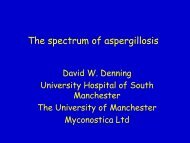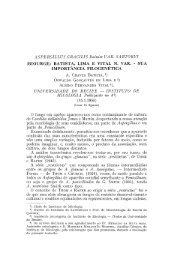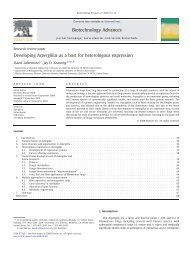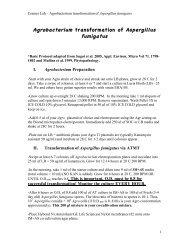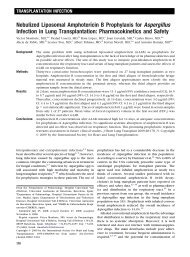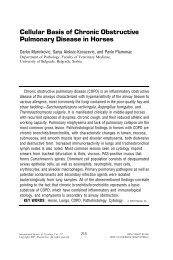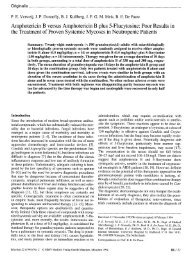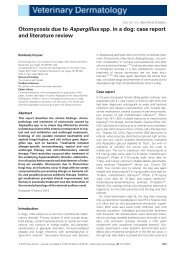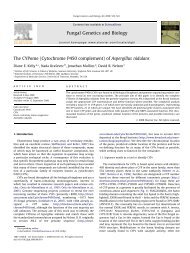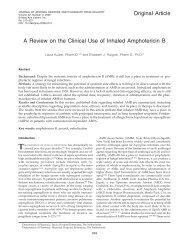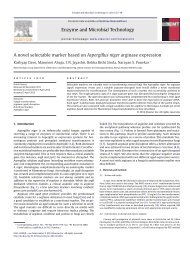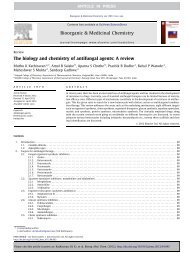Pharmacokinetic Optimization of Itraconazole Therapy
Pharmacokinetic Optimization of Itraconazole Therapy
Pharmacokinetic Optimization of Itraconazole Therapy
Create successful ePaper yourself
Turn your PDF publications into a flip-book with our unique Google optimized e-Paper software.
<strong>Pharmacokinetic</strong> <strong>Optimization</strong> <strong>of</strong> <strong>Itraconazole</strong> <strong>Therapy</strong><br />
Russell E. Lewis, Pharm.D.<br />
Assistant Pr<strong>of</strong>essor<br />
University <strong>of</strong> Houston College <strong>of</strong> Pharmacy, The University <strong>of</strong> Texas M.D. Anderson<br />
Cancer Center. Houston, TX<br />
Address for correspondence:1441 Moursund St #423, Texas Medical Center,<br />
Houston, TX 77030, USA. Tel: (713)-795-8326; Fax: (713)-795-8383<br />
e-mail:
Abstract<br />
<strong>Itraconazole</strong> is a broad-spectrum triazole antifungal with clinically useful activity against both<br />
superficial and systemic mycoses including Aspergillus species. In the past, the role <strong>of</strong><br />
itraconazole in the treatment <strong>of</strong> invasive aspergillosis was limited by the erratic bioavailability<br />
<strong>of</strong> the oral capsule formulation in immunocompromised patients. The reformulation <strong>of</strong><br />
itraconazole with hydroxypropyl-ß-cyclodextrin into an oral and intravenous solution, however,<br />
has revitalized the role <strong>of</strong> this antifungal in the treatment <strong>of</strong> fungal infections in critically-ill<br />
patients. Even with these new formulations, predicting an appropriate dosage <strong>of</strong> itraconazole<br />
for the individual patient remains problematic due to the considerable intra- and inter-patient<br />
variability <strong>of</strong> itraconazole pharmacokinetics. This monograph reviews key biopharmaceutical<br />
and pharmacokinetic concepts clinicians need to understand in order to individualize and<br />
optimize itraconazole dosing in a patients with invasive fungal infections.<br />
Introduction<br />
<strong>Itraconazole</strong> (Sporanox ® ) is a triazole antifungal that has been in clinical use<br />
for over a decade. Initially introduced as a capsule formulation, itraconazole was<br />
marketed for the treatment <strong>of</strong> both superficial (onychomycosis) and systemic<br />
(blastomycosis, histoplasmosis) fungal infections. <strong>Itraconazole</strong> was also the first<br />
azole antifungal agent approved for the treatment <strong>of</strong> invasive aspergillosis (IA) in<br />
patients who were refractory to, or intolerant <strong>of</strong> amphotericin B therapy (Denning et<br />
al., 1994). Early use <strong>of</strong> itraconazole for serious fungal infections, however, was<br />
limited by variability in the absorption and plasma drug concentrations that were<br />
achieved with the capsule formulation (Boogaerts and Maertens, 2001a). This<br />
variability was not problematic for the treatment <strong>of</strong> superficial fungal infections, as<br />
itraconazole accumulated to high concentrations in the skin and nail beds (De Beule<br />
and Van Gestel, 2001). For systemic fungal infections, however, consistent plasma<br />
concentrations are necessary for clinical efficacy (Poirier and Cheymol, 1998). In<br />
early studies examining the use <strong>of</strong> itraconazole capsules for antifungal prophylaxis in<br />
persistently neutropenic patients, > 40% <strong>of</strong> patients had low or undetectable plasma<br />
trough itraconazole levels after two weeks <strong>of</strong> daily dosing (Boogaerts et al., 1989;<br />
Glasmacher et al., 1998). Not surprisingly, breakthrough fungal infections were<br />
common in these patients with suboptimal itraconazole plasma levels (Boogaerts et<br />
al., 1989).<br />
2
To overcome the pharmacokinetic deficiencies <strong>of</strong> the capsule formulation, two<br />
new formulations <strong>of</strong> itraconazole (oral solution and IV formulation) were developed.<br />
The improved absorption and consistent plasma levels achieved with these new<br />
formulations has opened up the possibility <strong>of</strong> using itraconazole in more seriously-ill<br />
patients with invasive fungal infections. However, predicting an appropriate dosing<br />
strategy for itraconazole in the critically-ill patient remains a challenge due to the<br />
dose-dependent pharmacokinetic pr<strong>of</strong>ile, potential for multiple drug interactions, and<br />
substantial inter-patient variability in drug metabolism. To use itraconazole<br />
effectively, clinicians must understand key differences between the three<br />
itraconazole formulations, and recognize common “pharmacokinetic pitfalls” that can<br />
lead to sub-optimal drug levels. This monograph will provide a practical review <strong>of</strong> the<br />
biopharmaceutical differences between the three itraconazole formulations,<br />
summarize common dosing strategies including conversion from IV to oral therapy,<br />
and discuss the role <strong>of</strong> plasma drug level monitoring in the monitoring and dosing <strong>of</strong><br />
itraconazole.<br />
Biopharmaceutics <strong>of</strong> itraconazole<br />
The Problem <strong>of</strong> Adequate Dissolution<br />
<strong>Itraconazole</strong> is a synthetic triazole antifungal agent that is highly lipophilic<br />
and virtually insoluble in water. It is an extremely weak base (pKa =3.7) that is<br />
ionized only at low pH, such as that found in gastric fluid. Therefore, one <strong>of</strong> the<br />
initial problems associated with the oral administration <strong>of</strong> itraconazole is that <strong>of</strong><br />
insufficient dissolution in the stomach before the drug is delivered to the intestinal<br />
lumen for absorption (Figure 1). Dissolution <strong>of</strong> itraconazole is optimal at a pH 1-4,<br />
with impaired absorption occurring above these pH values (Lange et al., 1997).<br />
Gastric emptying rate also plays an important role in the absorption <strong>of</strong> solid<br />
itraconazole dosage forms. Generally, slower emptying rates will be associated with<br />
3
greater itraconazole dissolution and absorption. For this reason, it is recommended<br />
that itraconazole capsules be taken after a full meal for optimal dissolution.<br />
Figure 1. Gastrointestinal Dissolution and Absorption <strong>of</strong> <strong>Itraconazole</strong><br />
The Problem <strong>of</strong> Intestinal Absorption<br />
Once the drug is delivered in solution to the intestinal lumen, it is susceptible<br />
to the actions <strong>of</strong> a variety <strong>of</strong> plasma membrane transporters and metabolic enzymes<br />
located in intestinal enterocytes. Two mechanisms have been identified as important<br />
modulators <strong>of</strong> pre-systemic clearance/metabolism. P-glycoprotein (P-gp) is a<br />
versatile drug transporter found on the apical (luminal) plasma membrane surface <strong>of</strong><br />
mature enterocytes, where it functions as a “detoxification” pump that expels<br />
xenobiotics from the cytoplasm to the exterior <strong>of</strong> the cell (i.e from the enterocyte<br />
back to the intestinal lumen) (Hall et al., 1999). <strong>Itraconazole</strong> is both an inhibitor and<br />
substrate <strong>of</strong> P-gp. Hence, the ultimate effects <strong>of</strong> P-gp on intestinal absorption <strong>of</strong><br />
itraconazole can be mixed, or change over a period <strong>of</strong> prolonged exposure to<br />
itraconazole. Moreover, there is significant person-to-person variation in the<br />
intestinal expression <strong>of</strong> P-gp transporters; up to 4-fold variation in healthy<br />
volunteers to 10-fold variations in P-gp pump expression in medical patients (Hall et<br />
4
al., 1999). Patient diet, underlying disease, drug therapy, and genetics all play a role<br />
in P-gp expression (Hall et al., 1999). This variability in P-gp expression probably<br />
accounts for some <strong>of</strong> the intra and interpatient variability <strong>of</strong> itraconazole absorption.<br />
Figure 2. Intestinal Transport/Metabolism <strong>of</strong> <strong>Itraconazole</strong><br />
The second major mechanism <strong>of</strong> pre-systemic clearance <strong>of</strong> itraconazole<br />
involves intestinal metabolism by cytochrome P450 3A4 isoenzyme (CYP 3A4), which<br />
results in the production <strong>of</strong> both inactive and active metabolites. Hydroxy-<br />
itraconazole is an active metabolite <strong>of</strong> CYP 3A4-mediated metabolism that can be<br />
found in concentrations ~2x that <strong>of</strong> the parent drug, which suggests a major<br />
contribution to the overall mycological activity observed during itraconazole therapy<br />
(Poirier and Cheymol, 1998). Like P-gp, itraconazole is both a substrate and<br />
inhibitor <strong>of</strong> CYP 3A4 (Gubbins et al., 2001). The close cellular location <strong>of</strong> P-gp and<br />
CYP 3A4 in enterocytes and the overlapping substrate specificity suggest that the<br />
two mechanisms work synergistically to form a coordinated intestinal barrier to a<br />
variety <strong>of</strong> xenobiotics such as itraconazole (Hall et al., 1999). Additionally,<br />
expression <strong>of</strong> CYP 3A4 in enterocytes exhibits similar intra and interpatient variability<br />
as seen with P-gp and is not under coordinate regulation <strong>of</strong> CYP3A4 expression in the<br />
liver (Lown et al., 1994). Therefore, it is difficult to predict what effects increased<br />
drug doses, concomitant medications, or chemotherapy-induced changes in the<br />
intestinal lumen may have on the absorption <strong>of</strong> itraconazole. Studies examining<br />
5
plasma itraconazole trough levels with successive cycles <strong>of</strong> chemotherapy have<br />
shown that drug concentrations can either increase or decrease during each course<br />
<strong>of</strong> chemotherapy depending on the patient (Heykants et al., 1989). These changes in<br />
bioavailability could not be predicted from previous treatment courses/chemotherapy<br />
cycles with itraconazole.<br />
<strong>Itraconazole</strong> Distribution and Elimination<br />
<strong>Itraconazole</strong> that is absorbed into the systemic circulation is highly bound to<br />
red blood cells and plasma proteins (> 99%) (Poirier and Cheymol, 1998) Therefore,<br />
unbound concentrations <strong>of</strong> itraconazole in the body fluids (CSF, eye, saliva) are low<br />
in relation to plasma concentrations. However, tissue concentrations <strong>of</strong> itraconazole<br />
are generally 2-10 fold higher than concurrent plasma concentrations (Heykants et<br />
al., 1989). Especially high concentrations <strong>of</strong> itraconazole can be found in vaginal<br />
tissue and the horny layer <strong>of</strong> the nails, where drug levels remain elevated more than<br />
10 days after drug is cleared from the plasma (Heykants et al., 1989).<br />
Systemically-available itraconazole is extensively metabolized in the liver to<br />
both active and inactive metabolites, which are subsequently cleared by the kidneys.<br />
Approximately 50% <strong>of</strong> the drug is removed by first-pass metabolism in the liver (and<br />
intestinal lumen) resulting in a maximal oral bioavailability <strong>of</strong> approximately 50%<br />
(Heykants et al., 1989). However, this first-pass metabolism can be reversibly<br />
saturated with increasing itraconazole doses resulting in an absolute bioavailability ><br />
80% (Stevens, 1999). The terminal elimination half-life <strong>of</strong> itraconazole (t½ß) after a<br />
single oral dose is approximately 24 + 9 hours and 14 hours for the active hydroxy<br />
metabolite. Both active and non-active metabolites are excreted in the urine. Due to<br />
self-inhibition <strong>of</strong> its own metabolism, the half life <strong>of</strong> itraconazole generally increases<br />
to over 30 hours in patients after one week <strong>of</strong> therapy (Hardin et al., 1988).<br />
6
Approximately 3-18% <strong>of</strong> itraconazole (non-absorbed) is passed unchanged in the<br />
faeces (Poirier and Cheymol, 1998).<br />
Over a dosing range <strong>of</strong> 100-400 mg/day, itraconazole displays dose-<br />
dependent pharmacokinetics in healthy adults. However, at doses > 400 mg/day<br />
plasma concentrations are higher than might be expected from dosing because <strong>of</strong><br />
saturation <strong>of</strong> itraconazole CYP 3A4 metabolism in the gut and/or liver (Poirier and<br />
Cheymol, 1998). Plasma AUCs are generally 4-5x higher after 2-3 weeks <strong>of</strong> therapy<br />
compared to those achieved after a single dose (Heykants et al., 1989).<br />
Key <strong>Pharmacokinetic</strong> Differences <strong>of</strong> the <strong>Itraconazole</strong> Formulations<br />
Capsules<br />
As mentioned previously, one <strong>of</strong> the major drawbacks to administering<br />
itraconazole via the oral route lies in the poor solubility (dissolution) <strong>of</strong> the<br />
antifungal. The first strategy used to overcome this poor solubility involved the<br />
synthesis <strong>of</strong> antifungal-coated sugar spheres in a capsule formulation to maximize<br />
the available surface area for dissolution <strong>of</strong> itraconazole. This approach had limited<br />
success, however, in patients with drug or disease-related gastric hypochlorhydria<br />
(pH > 4); a common condition in seriously-ill pateints. In some cases, capsule<br />
absorption could be improved if the capsules were administered with an acidic<br />
beverage (i.e cola or juice) in divided doses (Poirier et al., 1997).<br />
Oral Solution<br />
A more successful approach towards the improvement <strong>of</strong> itraconazole<br />
absorption involved the incorporation <strong>of</strong> itraconazole into a 40% hydroxypropyl-ß-<br />
cyclodextrin (cyclodextrin) vehicle. Cyclodextrin is a ring <strong>of</strong> substituted glucose<br />
molecules that form a cylindrical structure with a hydrophobic inner pocket and a<br />
7
hydrophilic exterior. Lipophilic molecules such as itraconazole can be incorporated<br />
into this lipophilic pocket to improve their water solubility (Figure 3).<br />
Figure 3. Structural representation <strong>of</strong> the cyclodextrin molecule (adapted from<br />
references (Stevens, 1999; De Beule and Van Gestel, 2001)<br />
With the incorporation <strong>of</strong> itraconazole into the cyclodextrin vehicle, the<br />
problems <strong>of</strong> incomplete dissolution at high gastric pH are avoided. This was evident<br />
from pharmacokinetic studies performed in normal volunteers, which demonstrated<br />
30% higher AUC0-24 for the oral solution under fed conditions, and 60% higher AUC0-<br />
24 when the cyclodextrin/itraconazole solution is administered under fasting<br />
conditions (Van de Velde et al., 1996). Therefore, unlike the capsule formulation,<br />
itraconazole solution is generally taken on an empty stomach. Less than 3% <strong>of</strong><br />
cyclodextrin is absorbed from the gut in healthy adults, with 50-60% <strong>of</strong> the vehicle<br />
passing unchanged in the faeces (Stevens, 1999). The remaining cyclodextrin is<br />
broken down by gut micr<strong>of</strong>lora into constituent glucose molecules, which are then<br />
absorbed and metabolized by the liver. Like any polysaccharide, unchanged<br />
cyclodextrin passing through the gut stimulates intestinal secretion and<br />
gastrointestinal propulsion, thus resulting in nausea and/or osmotic diarrhoea<br />
(Stevens, 1999). Cyclodextrin-related gastrointestinal effects generally increase with<br />
escalating itraconazole dosages, especially when oral solution doses increase over<br />
400 mg/day (Glasmacher et al., 1999b)<br />
8
The oral solution formulation <strong>of</strong> itraconazole is unique in that it achieves high<br />
drug concentrations in the oral mucosa and saliva, presumably due to a topical effect<br />
<strong>of</strong> the solution (Mascarenas et al., 1998; Stevens, 1999). These high drug<br />
concentrations may persist for up to 8 hours after dosing, thus enabling the use <strong>of</strong><br />
the oral solution in the treatment <strong>of</strong> thrush or oral-oesophageal candidiasis.<br />
However, high drug concentrations in the saliva <strong>of</strong>ten cause alternations in<br />
perception and poor appetite in patients (Stevens, 1999). These annoying side<br />
effects <strong>of</strong>ten make long-term compliance with itraconazole solution problematic.<br />
Intravenous Formulation<br />
IV administration <strong>of</strong> itraconazole bypasses problems associated with oral<br />
absorption, as well mechanisms <strong>of</strong> pre-systemic clearance/metabolism in the gut and<br />
liver. Not surprisingly, the IV formulation achieves effective levels <strong>of</strong> itraconazole in<br />
the plasma much faster and with fewer side effects than oral administration<br />
(Boogaerts et al., 2001c; De Beule and Van Gestel, 2001). It has been suggested<br />
that trough plasma concentrations <strong>of</strong> at least 250-500 ng ml -1 are necessary for<br />
antifungal efficacy (Glasmacher et al., 1996; Glasmacher et al., 1999a). Considering<br />
the contribution <strong>of</strong> the hydroxyl-itraconazole active metabolite, this translates to an<br />
“effective” plasma trough itraconazole level <strong>of</strong> approximately 1000 ng ml -1 -a<br />
concentration that exceeds the minimum inhibitory concentration (MIC) for most<br />
Candida and Aspergillus spp. (Pfaller et al., 2002b). When itraconazole is<br />
administered intravenously as loading dose (200 mg q12 x 2 days), this therapeutic<br />
level is reliably achieved in most patients within 48 hours (Figure 4)(Caillot et al.,<br />
2001).<br />
9
Figure 4. <strong>Pharmacokinetic</strong>s <strong>of</strong> IV <strong>Itraconazole</strong> in Patients with Invasive Pulmonary<br />
Aspergillosis.<br />
<strong>Pharmacokinetic</strong>s <strong>of</strong> IV <strong>Itraconazole</strong><br />
(200 mg BID x 2 days, 200 mg qd) followed<br />
by oral itraconazole (200 mg BID) in IPA<br />
Concentration ng/ml<br />
7000<br />
6000<br />
5000<br />
4000<br />
3000<br />
2000<br />
1000<br />
0<br />
n = 17 16 11 8 5<br />
0 2 7 14<br />
Days<br />
56 96<br />
Caillot et al., Clin Infect Dis 2001;33:e83-e90.<br />
10<br />
ITRA<br />
OH-ITRA<br />
Therapeutic “threshold”<br />
plasma concentration<br />
The rapid attainment <strong>of</strong> “therapeutic” itraconazole levels in high risk patient<br />
populations is a major advantage <strong>of</strong> the IV versus oral formulations. Oral loading-<br />
dose regimens (i.e. 400 mg solution BID x 2 days, then 200 mg BID thereafter) have<br />
been proposed that can achieve therapeutic plasma concentrations almost as rapidly<br />
as IV dosing. However, these loading regimens are associated with a high incidence<br />
(> 35%) <strong>of</strong> nausea and diarrhoea among patients (Glasmacher et al., 1999b).<br />
Moreover, the use <strong>of</strong> oral loading doses <strong>of</strong> itraconazole is <strong>of</strong>ten not feasible among<br />
patients with chemotherapy-induced nausea and vomiting and/or mucositis.<br />
After IV administration <strong>of</strong> itraconazole, the cyclodextrin vehicle is quickly<br />
eliminated unchanged by glomerular filtration in the kidneys (De Beule and Van<br />
Gestel, 2001). Following a single itravenous dose <strong>of</strong> 200 mg IV itraconazole to<br />
subjects with severe renal impairment (CrCl < 19 ml/min), clearance <strong>of</strong> HPCD was<br />
reduced 6-fold compared to subjects with normal renal dysfunction (Zhou et al.,<br />
1998). Cyclodextrins have been associated in animal studies with toxic effects in the<br />
kidney, specifically cytoplasmic vacuolation in the epithelium <strong>of</strong> the renal tubules,<br />
renal pelvis, and urinary bladder. Hence, use <strong>of</strong> the IV formulation is not
ecommended in these patients even though the clinical implication <strong>of</strong> cyclodextrin<br />
accumulation in the humans is not well understood. In subjects with renal<br />
impairment and undergoing hemodialysis sessions three times per week, exposure,<br />
in terms <strong>of</strong> the concentration at the end <strong>of</strong> infusion, to sulphobutyl ether b -<br />
cyclodextrin (SBECD)is higher (455%) in these subjects than in subjects with normal<br />
renal function. SBECD is dialyzed at a clearance rate <strong>of</strong> 55 ml/min. SBECD is used to<br />
solubilise voriconazole – little data is available <strong>of</strong> the clearance <strong>of</strong> the HPCD vehicle<br />
used for solubilising itraconazole. No data is available on clearance by<br />
haem<strong>of</strong>iltration <strong>of</strong> either vehicle.<br />
<strong>Itraconazole</strong> dosing strategies, IV/Oral Conversion<br />
Once steady state concentrations are reached, any <strong>of</strong> the three itraconazole<br />
formulations can be used to maintain plasma concentrations at an effective level<br />
provided the patient does not have any contraindications to oral therapy or drug<br />
interactions that impair the absorption <strong>of</strong> the oral formulations. Therefore, the initial<br />
factor that needs to be considered when optimizing the itraconazole dosing is that <strong>of</strong><br />
urgency-namely, how quickly does the patient need “full” therapeutic concentrations<br />
<strong>of</strong> itraconazole? The IV formulation <strong>of</strong> itraconazole should be used initially in any<br />
critically-ill patient or any patient where the full effect antifungal therapy is needed<br />
within the next 48-72 hours. <strong>Therapy</strong> is initiated with a loading dose <strong>of</strong> 200 mg IV<br />
q12x 2 days, then 200 mg/day maintenance dose thereafter (Figure 5). If IV access<br />
is not available, clinicians can attempt to administer an oral loading regimen using<br />
either the oral solution (400 mg BID x2 days) or a combination <strong>of</strong> solution and<br />
capsules (400 mg solution plus 200 mg capsules QID x 7 days). However, oral<br />
loading doses are associated with a higher frequency <strong>of</strong> nausea and diarrhoea,<br />
especially among patients receiving oral solution at doses > 400 mg/day<br />
(Glasmacher et al., 1999b). In most cases, IV–administered loading doses will be<br />
11
the best tolerated and most reliable method for achieving effective plasma<br />
concentrations <strong>of</strong> itraconazole.<br />
Patients initially receiving IV itraconazole can be safely converted to either<br />
the oral capsule or solution formulation once they are medically stable and have<br />
reliable GI function/absorption. Plasma itraconazole levels will <strong>of</strong>ten remain at the<br />
same level or even moderately increase after conversion to oral therapy (Zhou et al.,<br />
1998; Caillot et al., 2001). Moreover, the daily drug cost for the oral formulations<br />
are considerably less than the cost <strong>of</strong> the IV formulation. Determining which oral<br />
formulation can be used in the individual patient depends upon patient-specific risk<br />
factors. Although the solution has uniformly better absorption than the capsules and<br />
can be taken without food, the solution may be less well tolerated due to nausea,<br />
diarrhoea, and persistent taste disturbance. Also the solution formulation is<br />
somewhat dilute (10 mg/ml), requiring 2 bottles (150 ml/bottle) per week to take<br />
the standard oral maintenance dose <strong>of</strong> 200 mg BID. Therefore, prolonged or chronic<br />
maintenance therapy is <strong>of</strong>ten more practical with the capsule formulation. However,<br />
the capsule formulation is susceptible to a wider variety <strong>of</strong> disease and drug-related<br />
factors that can decrease absorption. Many patients at risk for invasive fungal<br />
infections possess some degree <strong>of</strong> hypochlorhydria secondary to underlying disease<br />
or chemotherapy, and thus are not good candidates for itraconazole capsules. Drug<br />
level monitoring can help identify which formulation is appropriate for the individual<br />
patient.<br />
12
Figure 5. Approach to itraconazole dosing in the high-risk patient (Adapted from:<br />
Poirier and Cheymol, 1998; Zhou et al., 1998; Glasmacher et al., 1999b; Boogaerts<br />
et al., 2001b; Caillot et al., 2001)<br />
No<br />
<strong>Itraconazole</strong> oral<br />
solution: 200 mg q12h<br />
Consider checking<br />
plasma trough level at<br />
day 7<br />
Oral maintenance<br />
regimens:<br />
Solution: 200 mg BID<br />
Capsules: 200 mg BID<br />
"Therapeutic" Drug<br />
levels: ~ 7 days<br />
No<br />
Does the patient have/<br />
require IV access?<br />
No<br />
Is immediate<br />
antifungal activity<br />
critical?<br />
<strong>Itraconazole</strong> IV: 200 mg q12h x 2 days<br />
13<br />
No<br />
IV maintenance regimen:<br />
200 mg q24h<br />
If patient is medically stable and no<br />
contraindications, consider switch<br />
to oral therapy<br />
"Therapeutic" Drug<br />
levels: ~2 days<br />
Yes<br />
Contraindication to IV<br />
administration?<br />
Consider checking plasma trough concentrations when:<br />
• New medications are started that might increase itraconazole metabolism (3A4 inducers)<br />
• When itraconazole formulation is changed during maintenance therapy<br />
• During or immediately following cycles <strong>of</strong> chemotherapy (neutropenia, mucositis)<br />
• Any pateint with graft-versus-host disease<br />
• Any patent with moderate to severe liver dysfunction<br />
• Anytime poor compliance is suspected<br />
• Anytime poor oral absorption is suspected (new onset N&V, mucositis, or drug interactions)<br />
• Anytime breakthrough fungal infection is suspected<br />
Goal: Plasma trough > 500 ng/ml<br />
* Oral loading-dose regimens are associated with higher incidence <strong>of</strong> nausa/diarrhoea, and may not be tolerated in<br />
patients who are already experiencing nausea with chemotherapy. Approximately 35% <strong>of</strong> patients receiving 800 mg/<br />
day itraconazole report N&V, diarrhoea. Capsule/solution loading-dose combination appears to have less GI adverse<br />
effects (Glasmacher et al. 1999).<br />
Yes<br />
Oral loading-dose regimens:*<br />
Solution (800 mg/day x 2 days):<br />
800 mg BID x 2 days<br />
or<br />
Capsules + solution (1200 mg/day x 7days):<br />
400 mg solution QD +<br />
200 mg capsules QID<br />
Oral maintenance<br />
regimens:<br />
Solution: 200 mg BID<br />
Capsules: 200 mg BID
Plasma drug level monitoring during itraconazole therapy<br />
Efficacy monitoring<br />
Plasma drug level monitoring during itraconazole therapy is clinically indicated<br />
in any patient at risk for developing a life-threatening fungal infection, suspected<br />
cases <strong>of</strong> drug failure or infection relapse, or in patients with other risk factors for<br />
inadequate plasma drug levels (Figure 5)(1993; Graybill, 1994; Poirier and Cheymol,<br />
1998). As mentioned previously, data from early clinical trials suggest a plasma<br />
trough concentration <strong>of</strong> > 250 ng ml -1 <strong>of</strong> unmetabolized itraconazole is necessary for<br />
antifungal efficacy (Tricot et al., 1987; Boogaerts et al., 1989). More recent work by<br />
Glasmacher et al. have suggested that an itraconazole trough concentration <strong>of</strong> at<br />
least 500 ng ml -1 is needed to prevent the development <strong>of</strong> Aspergillus infections in<br />
neutropenic patients (Glasmacher et al., 1996; Glasmacher et al., 1999a).<br />
Considering the contribution <strong>of</strong> the active hydroxy-metabolite, a plasma trough<br />
concentration <strong>of</strong> 500 ng ml -1 <strong>of</strong> parent drug plus metabolite would equate to roughly<br />
1000 ng ml -1 <strong>of</strong> itraconazole activity - a concentration that inhibits over 70-90% <strong>of</strong><br />
common fungal pathogens including Aspergillus spp. in vitro (Pfaller et al., 2002a;<br />
Pfaller et al., 2002b).<br />
A conservative provisional target for patients receiving itraconazole,<br />
therefore, would be plasma steady-state trough itraconazole concentrations > 500<br />
ng ml -1 . Plasma trough itraconazole levels should be determined by HPLC assay,<br />
when possible, as interpretation <strong>of</strong> bioassay results is confounded by the presence <strong>of</strong><br />
the active metabolite (Law et al., 1999). Measurement <strong>of</strong> the active hydroxyl-<br />
metabolite <strong>of</strong> itraconazole can also be performed by HPLC, and provides<br />
complimentary data in addition to itraconazole levels (Poirier and Cheymol, 1998).<br />
However the HPLC measurement <strong>of</strong> itraconazole is cumbersome (because <strong>of</strong> the<br />
complex and time consuming extraction procedure) and a faster turnaround time can<br />
be achieved, with much less precision using bioassay measurements. Using<br />
14
itraconazole standards the bioassay measurement overestimates itraconazole<br />
concentrations by perhaps 5 times, because <strong>of</strong> the presence <strong>of</strong> the<br />
hydroxyitraconazole metabolite. Excellent correlation can be achieved between<br />
bioassay and HPLC if hydroxyitraconazole is used as the standard in the bioassay<br />
(Law et al, 1994), but the hydoxyitraconazole metabolite is not easily available.<br />
Bioassay may be problematic in the context <strong>of</strong> combination therapy as well.<br />
Generally, the initial plasma concentrations should be determined once the patient<br />
reaches steady-state levels (typically 1 week after starting itraconazole therapy).<br />
Subsequent plasma level monitoring is then performed on the basis <strong>of</strong> patient-<br />
specific risk factors (Figure 5).<br />
If a plasma itraconazole level measured at steady state comes back low (<<br />
500 ng ml -1 by HPLC, or ~3-5mcg/ml by bioassay) or is undetectable, a repeat<br />
plasma trough concentration should be considered if assay turnaround is reasonably<br />
short(< 7 days). If a patient has a plasma trough level between 200-500 ng ml -1 ,<br />
dosing adjustment may not be necessary if the level was taken within 1 week <strong>of</strong><br />
starting oral therapy. However, if the plasma trough concentration is < 200 ng ml -1<br />
or undetectable, prescribers should re-administer an IV or oral loading dose <strong>of</strong><br />
itraconazole and consider possible causes <strong>of</strong> low itraconazole levels (Table 1).<br />
15
Table1. Common factors that contribute to sub-optimal itraconazole plasma<br />
concentrations.<br />
Problem Mechanism Suggested Strategy<br />
pH interactions (capsules)<br />
Drug interactions<br />
H2 antagonists (i.e famotidine)<br />
Proton pump inhibitors (i.e omeprazole)<br />
Antacids, didanosine tablets<br />
Disease state<br />
Chemotherapy-associated hypochlorhydria<br />
Graft-versus-host disease<br />
Neutropenia/mucositis<br />
AIDS<br />
Complexation/Chelation Interactions<br />
(capsules, solution?)<br />
Drug interactions<br />
Sucralfate<br />
Multivitamins<br />
Antacids<br />
Increases systemic clearance (all<br />
formulations)<br />
Drug interactions<br />
Rifampin<br />
Rifabutin<br />
Phenytoin<br />
Phenobarbital<br />
Carbamazepine<br />
Decreased dissolution <strong>of</strong> capsule<br />
results in decreased absorption<br />
Complexation with metal ions<br />
decreases transport across<br />
intestinal epithelium resulting in<br />
decreased absorption<br />
Induction <strong>of</strong> CYP3A4 metabolism<br />
results in decrease (30-90%) in<br />
plasma Cmax, AUC and t½.<br />
Effects may last 1-2 weeks after<br />
drug are stopped<br />
Toxicity monitoring<br />
Common adverse effects <strong>of</strong> itraconazole therapy include gastrointestinal<br />
effects (N&V, diarrhoea), skin rash, and reversible increases in hepatic enzymes<br />
(Janssen, 2002). Less common but more severe side effects such as congestive<br />
heart failure and idiosyncratic hepatic failure have been reported (Ahmad et al.,<br />
2001; Janssen, 2002). Currently, no correlation between plasma itraconazole levels<br />
and the frequency or occurrence <strong>of</strong> toxicity during itraconazole therapy has been<br />
demonstrated (Graybill, 1994; Poirier and Cheymol, 1998). Additionally, there are<br />
16<br />
Change to solution formulation<br />
Avoid taking antacids within 2 hours<br />
<strong>of</strong> itraconazole capsules<br />
Avoid taking binding agent (antacid,<br />
multivitamin, etc.) within 2 hours <strong>of</strong><br />
itraconazole dose<br />
Avoid concomitant use <strong>of</strong> these agents<br />
with itraconazole. May need to switch<br />
to amphotericin B or echinocandin<br />
If itraconazole must be used with<br />
potent inducing agent, prescriber may<br />
be able increase dose to compensate<br />
for increased clearance (not possible<br />
to achieve with rifampin). Dosing<br />
should be guided by plasma<br />
monitoring.
no reports <strong>of</strong> using plasma level monitoring to guide itraconazole dosing in patients<br />
with moderate to severe hepatic dysfunction. In general, use <strong>of</strong> itraconazole should<br />
be avoided in these with severe liver disease (Janssen, 2002). However, if<br />
itraconazole is used, concurrent monitoring <strong>of</strong> itraconazole levels along with hepatic<br />
enzymes and billirubin may be prudent given that liver disease is associated with<br />
multiple factors (e.g. protein binding, drug distribution) that can affect drug<br />
distribution and clearance (Lewis and Prince, 2001).<br />
Because itraconazole is substrate <strong>of</strong> CYP 3A4, concurrent use <strong>of</strong> itraconazole<br />
with potent CYP 3A4 inhibitors (e.g. macrolides, and the protease inhibitors indinavir<br />
and ritonavir) could increase plasma drug levels and the likelihood <strong>of</strong> adverse effects<br />
during itraconazole therapy. However, <strong>of</strong> the few studies that have examined the<br />
concomitant use <strong>of</strong> itraconazole and CYP 3A4 inhibitors, itraconazole levels did not<br />
appear to be substantially increased (Auclair et al., 1999; Dresser et al., 2000)<br />
Therefore, it appears that itraconazole can be used safely with medications that<br />
inhibit CYP 3A4 and plasma level monitoring is not routinely indicated. The long-<br />
term consequences <strong>of</strong> co-administering itraconazole with CYP 3A4 inhibitors,<br />
however, has not been examined (Auclair et al., 1999).<br />
Conclusion<br />
For nearly a decade, sub-optimal pharmacokinetics has prevented<br />
itraconazole from achieving its full potential in the management <strong>of</strong> serious fungal<br />
infections such as invasive aspergillosis This is no longer the case, as clinicians now<br />
have two new formulations <strong>of</strong> itraconazole that can rapidly and reliably achieve<br />
adequate plasma drug concentrations in the critically-ill patient. Effective use <strong>of</strong><br />
itraconazole still requires an individualized approach to dosing and careful<br />
monitoring. However, the added flexibility <strong>of</strong> these new formulations are a major<br />
advancement for the antifungal armamentarium, and are especially encouraging in<br />
the treatment <strong>of</strong> infections for which few therapeutic options are available.<br />
17
Acknowledgments<br />
The author thanks Dr. Dimitrios P. Kontoyiannis for his review <strong>of</strong> this monograph.<br />
18
References<br />
Tricot G, Joosten E, Boogaerts MA, Vande Pitte J, Cauwenbergh G. Ketoconazole vs.<br />
itraconazole for antifungal prophylaxis in patients with severe granulocytopenia:<br />
preliminary results <strong>of</strong> two nonrandomized studies. Rev Infect Dis. 1987;9 Suppl 1:<br />
S94-9.<br />
Hardin TC, Graybill JR, Fetchick R, Woestenborghs R, Rinaldi MG, Kuhn, JG.<br />
<strong>Pharmacokinetic</strong>s <strong>of</strong> itraconazole following oral administration to normal volunteers.<br />
Antimicrob Agents Chemother. 1998;32:1310-3.<br />
Boogaerts MA, Verhoef GE, Zachee P, Demuynck H, Verbist L, De Beule K. Antifungal<br />
prophylaxis with itraconazole in prolonged neutropenia: correlation with plasma<br />
levels. Mycoses. 1989;32 Suppl 1:103-8.<br />
Heykants J, Van Peer A, Van de Velde V, Van Rooy P, Meuldermans W, Lavrijsen K,<br />
Woestenborghs R, Van Cutsem J, Cauwenbergh G. The clinical pharmacokinetics <strong>of</strong><br />
itraconazole: an overview. Mycoses. 1989;32 Suppl 1:67-87.<br />
Chemoprophylaxis for candidosis and aspergillosis in neutropenia and<br />
transplantation: a review and recommendations. Working party <strong>of</strong> the British Society<br />
for Antimicrobial Chemotherapy. J Antimicrob Chemother. 1993;32:5-21.<br />
Denning DW, Lee JY, Hostetler JS, Pappas P, Kauffman CA, Dewsnup DH, Galgiani<br />
JN, Graybill JR, Sugar AM, Catanzaro A, et al. NIAID Mycoses Study Group<br />
Multicenter Trial <strong>of</strong> Oral <strong>Itraconazole</strong> <strong>Therapy</strong> for Invasive Aspergillosis. Am J Med.<br />
1994;97:135-44.<br />
Graybill, JR Is there a correlation between serum antifungal drug concentration and<br />
clinical outcome? J Infect. 1994;28 Suppl 1:17-24.<br />
Lown KS, Kolars JC, Thummel KE, Barnett JL, Kunze KL, Wrighton SA, Watkins PB<br />
Interpatient heterogeneity in expression <strong>of</strong> CYP3A4 and CYP3A5 in small bowel. Lack<br />
<strong>of</strong> prediction by the erythromycin breath test. Drug Metab Dispos. 1994;22:947-55.<br />
Law D, Moore CB, Denning DW. A new bioassay for serum itraconazole<br />
concentrations using hydroxyitraconazole standards. Antimicrobial Agents<br />
Chemother 1994; 38: 1561-1566.<br />
Glasmacher A, Molitor E, Mezger J, Marklein G. Antifungal prophylaxis with<br />
itraconazole in neutropenic patients: pharmacological, microbiological and clinical<br />
aspects. Mycoses. 1996;39:249-58.<br />
Van de Velde VJ, Van Peer AP, Heykants JJ, Woestenborghs RJ, Van Rooy P, De<br />
Beule KL, Cauwenbergh GF. Effect <strong>of</strong> food on the pharmacokinetics <strong>of</strong> a new<br />
hydroxypropyl-beta-cyclodextrin formulation <strong>of</strong> itraconazole. Pharmacotherapy.<br />
1996;16:424-8.<br />
Lange D, Pavao JH, Wu J,Klausner M. Effect <strong>of</strong> a cola beverage on the bioavailability<br />
<strong>of</strong> itraconazole in the presence <strong>of</strong> H2 blockers. J Clin Pharmacol. 1997;37:535-40.<br />
Poirier JM, Hardy S, Isnard F, Tilleul P, Weissenburger J, Cheymol, G. Plasma<br />
itraconazole concentrations in patients with neutropenia: advantages <strong>of</strong> a divided<br />
daily dosage regimen. Ther Drug Monit. 1997;19:525-9.<br />
Glasmacher A, Molitor E, Hahn C, Bomba K, Ewig S, Leutner C, Wardelmann E,<br />
Schmidt-Wolf IG, Mezger J, Marklein G, Sauerbruch T. Antifungal prophylaxis with<br />
itraconazole in neutropenic patients with acute leukaemia. Leukemia. 1998;12,<br />
1338-43.<br />
19
Mascarenas CA, Hardin TC, Pennick GJ, Rinaldi MG, Graybill JR. Treatment <strong>of</strong> thrush<br />
with itraconazole solution: evidence for topical effect. Clin Infect Dis. 1998;26:1242-<br />
3.<br />
Poirier JM, Cheymol G. Optimisation <strong>of</strong> itraconazole therapy using target drug<br />
concentrations. Clin Pharmacokinet. 1998;35:461-73.<br />
Zhou H, Goldman M, Wu J, Woestenborghs R, Hassell AE, Lee P, Baruch A, Pesco-<br />
Koplowitz L, Borum J, Wheat LJ. A pharmacokinetic study <strong>of</strong> intravenous itraconazole<br />
followed by oral administration <strong>of</strong> itraconazole capsules in patients with advanced<br />
human immunodeficiency virus infection. J Clin Pharmacol. 1998;38:593-602.<br />
Auclair B, Berning SE, Huitt GA, Peloquin CA. Potential interaction between<br />
itraconazole and clarithromycin. Pharmacotherapy. 1999;19:1439-44.<br />
Glasmacher A, Hahn C, Leutner C, Molitor E, Wardelmann E, Losem C, Sauerbruch T,<br />
Marklein G, Schmidt-Wolf, IG. Breakthrough invasive fungal infections in neutropenic<br />
patients after prophylaxis with itraconazole. Mycoses. 1999a;42:443-51.<br />
Glasmacher A, Hahn C, Molitor E, Marklein G, Sauerbruch T, Schmidt-Wolf IG,<br />
<strong>Itraconazole</strong> through concentrations in antifungal prophylaxis with six different<br />
dosing regimens using hydroxypropyl-beta-cyclodextrin oral solution or coated-pellet<br />
capsules. Mycoses. 1999b;42:591-600.<br />
Hall SD, Thummel KE, Watkins PB, Lown KS, Benet LZ, Paine MF, Mayo RR, Turgeon<br />
DK, Bailey DG, Fontana RJ, Wrighton SA Molecular and physical mechanisms <strong>of</strong> firstpass<br />
extraction. Drug Metab Dispos. 1999;27:161-6.<br />
Law D, Moore CB, Denning DW. Discrepancies associated with the measurement <strong>of</strong><br />
itraconazole serum concentrations by bioassays. J Antimicrob Chemother. 1999;44:<br />
577-8.<br />
Stevens DA. <strong>Itraconazole</strong> in cyclodextrin solution. Pharmacotherapy. 1999;19:603-<br />
11.<br />
Dresser GK, Spence JD, Bailey DG <strong>Pharmacokinetic</strong>-pharmacodynamic consequences<br />
and clinical relevance <strong>of</strong> cytochrome P450 3A4 inhibition. Clin Pharmacokinet. 2000;<br />
38:41-57.<br />
Ahmad SR, Singer SJ, Leissa BG. Congestive heart failure associated with<br />
itraconazole. Lancet. 2001;357:1766-7.<br />
Boogaerts M, Maertens J. Clinical experience with itraconazole in systemic fungal<br />
infections. Drugs. 2001a;61 Suppl 1:39-47.<br />
Boogaerts M, Winston DJ, Bow EJ, Garber G, Reboli AC, Schwarer, AP, Novitzky N,<br />
Boehme A, Chwetz<strong>of</strong>f E, De Beule K. Intravenous and oral itraconazole versus<br />
intravenous amphotericin B deoxycholate as empirical antifungal therapy for<br />
persistent fever in neutropenic patients with cancer who are receiving broadspectrum<br />
antibacterial therapy. A randomized, controlled trial. Ann Intern Med.<br />
2001b;135:412-22.<br />
Boogaerts MA, Maertens J, Van Der Geest R, Bosly A, Michaux JM, Van Ho<strong>of</strong> A,<br />
Cleeren M, Wostenborghs R, De Beule K. <strong>Pharmacokinetic</strong>s and safety <strong>of</strong> a 7-day<br />
administration <strong>of</strong> intravenous itraconazole followed by a 14-day administration <strong>of</strong><br />
itraconazole oral solution in patients with hematologic malignancy. Antimicrob Agents<br />
Chemother. 2001c;45:981-5.<br />
Caillot D, Bassaris H, McGeer A, Arthur C, Prentice HG, Seifert W, De Beule K.<br />
Intravenous itraconazole followed by oral itraconazole in the treatment <strong>of</strong> invasive<br />
pulmonary aspergillosis in patients with hematologic malignancies, chronic<br />
granulomatous disease, or AIDS. Clin Infect Dis. 2001;33:e83-90.<br />
20
De Beule K, Van Gestel J. Pharmacology <strong>of</strong> itraconazole. Drugs. 2001;61 Suppl 1,<br />
27-37.<br />
Gubbins PO, McConnell SA & Penzak SR Antifungal Agents. In: Drug Interactions in<br />
Infectious Diseases. Piscetelli SC,Rodvold KA, editors. Totowa, NJ: Human<br />
Press;2001. P. 185-217.<br />
Lewis RE, Prince RA. Overview <strong>of</strong> the pharmacokinetic and pharmacodynamic<br />
principles <strong>of</strong> anti-infective dosing in the neutropenic pateint. In: Textbook <strong>of</strong> Febrile<br />
Neutropenia. Rolston KVI, Rubenstein EB, editors. London: Martin Dunitz;2001.<br />
P.27-43.<br />
Janssen. Sporanox Package Insert. 2002.<br />
Pfaller MA, Diekema DJ, Jones RN, Messer SA & Hollis RJ. Trends in Antifungal<br />
Susceptibility <strong>of</strong> Candida spp. Isolated from Pediatric and Adult Patients with<br />
Bloodstream Infections: SENTRY Antimicrobial Surveillance Program, 1997 to 2000. J<br />
Clin Microbiol. 2002a;40:852-856.<br />
Pfaller MA, Messer SA, Hollis RJ, Jones RN. Antifungal activities <strong>of</strong> posaconazole,<br />
ravuconazole, and voriconazole compared to those <strong>of</strong> itraconazole and amphotericin<br />
B against 239 clinical isolates <strong>of</strong> Aspergillus spp. and other filamentous fungi: Report<br />
from SENTRY antimicrobial surveillance Program. Antimicrob Agents Chemother.<br />
2002b;46:1032-1037.<br />
21



